Confounding
What If: Chapter 7
Elena Dudukina
2021-02-04
Confounding
Lack of exchangeability
🧀
↙️ ↘️
🐿 🐿 🐿 🐿 🐿 🐿 🐿 🐿 🐿 🐿 🐿 🐿 🐿 🐿 🐿 🐿 🐿 🐿 🐿 🐿 🐿 🐿 🐿 🐿 🐿 🐿 🐿 🐿 🐿 🐿 🐿 🐿 🐿 🐿 🐿 🐿 🐿 🐿 🐿 🐿🐿 🐿 🐿 🐿 🐿 🐿 🐿 🐿 🐿 🐿 🐿 🐿 🐿 🐿 🐿 🐿 🐿 🐿 🐿 🐿 🐿 🐿 🐿 🐿 🐿 🐿 🐿 🐿 🐿 🐿 🐿 🐿 🐿 🐿 🐿 🐿 🐿 🐿 🐿 🐿 🐿 🐿 🐿 🐿 🐿 🐿 🐿 🐿 🐿 🐿 🐿 🐿 🐿 🐿🐿 🐿 🐿 🐿 🐿 🐿 🐿 🐿
🐭 🐭 🐭 🐭 🐭 🐭 🐭 🐭 🐭 🐭 🐭 🐭 🐭 🐭 🐭 🐭 🐭 🐭 🐭 🐭 🐭 🐭 🐭 🐭 🐭 🐭 🐭 🐭 🐭 🐭 🐭 🐭 🐭 🐭 🐭 🐭 🐭 🐭 🐭 🐭 🐭 🐭 🐭 🐭 🐭 🐭 🐭 🐭 🐭 🐭 🐭 🐭 🐭 🐭 🐭 🐭 🐭 🐭 🐭 🐭 🐭 🐭 🐭 🐭 🐭 🐭 🐭 🐭 🐭 🐭 🐭 🐭 🐭 🐭 🐭 🐭 🐭 🐭 🐭 🐭 🐭 🐭 🐭 🐭 🐭 🐭 🐭 🐭 🐭 🐭 🐭 🐭 🐭 🐭 🐭 🐭 🐭 🐭 🐭 🐭 🐭 🐭
?
7.1 The structure of confounding
Bias due to common causes
- A: treatment
- Y: outcome
- L: confounder (a common cause of A and Y)
Paths between A and Y
- A ➡️ Y: causal effect (directed path)
- A ⬅️ L ➡️ Y: biasing backdoor path (starts with a head pointing into A)
- The associational risk ratio Pr[Y=1|A=1]Pr[Y=1|A=0] is not causal risk ratio Pr[Ya=1]Pr[Ya=0]

7.1 Examples
Occupational factors (healthy worker bias)
- A: working as a firefighter
- Y: mortality
- L: being fit to work as a firefighter
Confounding by indication (channeling bias)
- A: drug (aspirin)
- Y: mortality
- L: indication for the drug (heart disease)
- U: (unmeasured) atherosclerosis

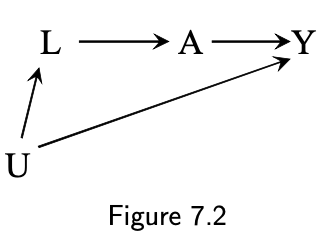
Lifestyle
- A: behavior (exercise)
- Y: mortality
- L: lifestyle (smoking)
- U: (unmeasured) personality/socioeconomic determinants
Reverse causation
- A: behavior
- Y: clinical disease
- L: lifestyle (smoking)
- U: (unmeasured) subclinical disease
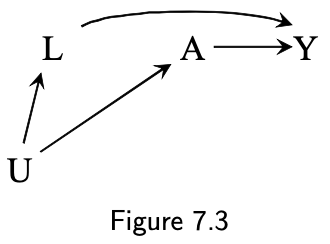

Genetic factors (linkage disequilibrium)
- A: DNA sequence
- Y: developing a trait
- L: DNA sequence confounding effect of A if L and A are often being inherited together and L causes Y
- U: ethnicity
Social factors
- A: income at age 65
- Y: disability at age 75
- L: disability at age 55
- Time-varying flavor
Environmental exposures
- A: airborne particle
- Y: coronary heart disease
- L: other pollutants, which levels co-vary together with A
- U: (unmeasured) weather (controls the level of all types of airborne pollutants)
Assumptions for the remainder of the chapter
No selection bias (Chapter 8)
No measurement bias (Chapter 9)
No random variabiity (Chapter 10)
7.2 Confounding and exchangeability
Assuming consistency and positivity hold
- Exchangeability holds Ya⊥⊥A: potential outcome under the treatment regime is independent from actually observed treatment for all treatment levels (perfect randomization)
7.2 Confounding and exchangeability
Assuming consistency and positivity hold
Exchangeability holds Ya⊥⊥A: potential outcome under the treatment regime is independent from actually observed treatment for all treatment levels (perfect randomization)
When Ya⊥⊥A is true and treatment is binary
- the average causal effect E[Ya=1]−E[Ya=0] equals the observed associational effect E[Y|A=1]−E[Y|A=0]
7.2 Confounding and exchangeability
Assuming consistency and positivity hold
Exchangeability holds Ya⊥⊥A: potential outcome under the treatment regime is independent from actually observed treatment for all treatment levels (perfect randomization)
When Ya⊥⊥A is true and treatment is binary
- the average causal effect E[Ya=1]−E[Ya=0] equals the observed associational effect E[Y|A=1]−E[Y|A=0]
When conditional exchangeability holds Ya⊥⊥A|L, the verage caussal effect is identifiable
- E[Ya=1]−E[Ya=0]=ΣlE[Y|L=l,A=1]∗Pr[L=l]−ΣlE[Y|L=l,A=0]∗Pr[L=l]
- G-methods (IPTW, standardization) for marginal estimates
Is there a set of variables L that guarantees conditional exchangeability holds?
No guarantees (unless well-conducted RCT)
- Use of DAGs to show the data-generating mechanism and assumptions
- No residual confounding (conditional exchangeability) assumption
- Backdoor criterion (J. Pearl, 1995)
- No node in adjustment set is a descendant (child) of exposure (not a mediator)
- The adjustment set blocks all paths pointing into exposure (blocks all backdoor paths)
- Consider magnitude and te direction of bias by unmeasured confounding
7.3 Confounding and the backdoor criterion
Adjustment sets sufficient to eliminate confounding:
- 7.2: {L}, {U}
- 7.3: {L}, {U}
7.4: {} (empty set)
- adjusting for L opens a biasing path
- A ⬅️ U2 ➡️ [L] ⬅️ U1 ➡️ Y
think confounding, not confounders
- role of the variable changes when other variables are adjusted


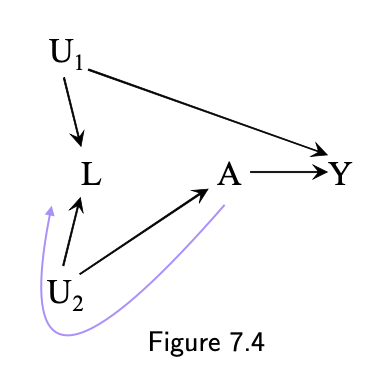
Fig 7.5
- A ⬅️ L ⬅️ U1 ➡️ Y (open biasing path, L is not a collider)
- A ⬅️ U2 ➡️ L ⬅️ U1 ➡️ Y (biasing path is closed with the collider L)
- {U1}, {L, U2}, {L, U1}
Fig 7.6
- {L1}, {U1}, {L, L2}, {L, U2}, {L, L1}, {L, U1}
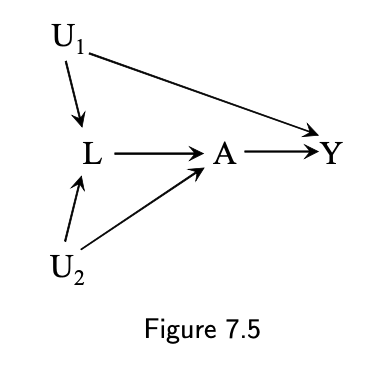
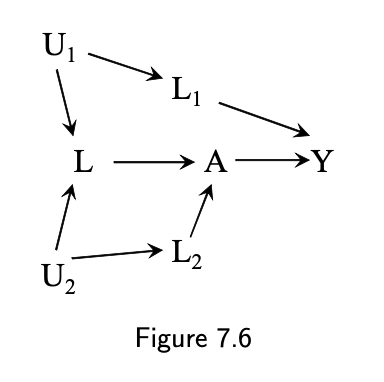
7.4 Confounding and confounders
Traditional criteria
- Association with the exposure
- Association with the outcome
- Not on a causal pathway
Change of the estimate after adjustment may occur for the reasons other than adjusting confounding (selection bias, non-collapsibility of effect measures)

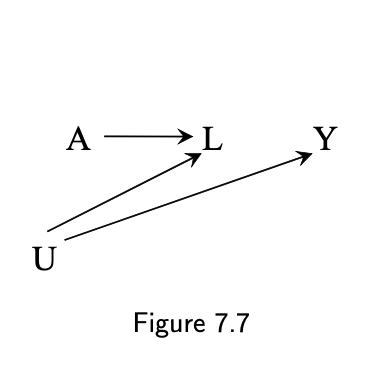
Is L a confounder?
7.6 Confounding adjustment
- Sufficient set for confounding adjustment
- Methods
- G-methods (marginal and conditional effects)
- Standardization
- IP weighting (deleting an arrow L ➡️ A)
- g-estimation
- Stratification-based methods (conditional effects only)
- Stratification
- Restriction
- Matching
- G-methods (marginal and conditional effects)
References
Hernán MA, Robins JM (2020). Causal Inference: What If. Boca Raton: Chapman & Hall/CRC (v. 31jan21)